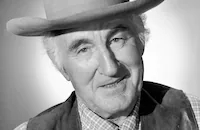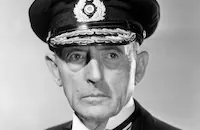Shining Victory

Brief Synopsis
Cast & Crew
Irving Rapper
James Stephenson
Geraldine Fitzgerald
Donald Crisp
Barbara O'neil
Montagu Love
Film Details
Technical Specs

Synopsis
In Budapest in 1935, Dr. Paul Venner, a medical researcher, is stunned when a published article attributes the conclusions of his research on the biochemical origins of schizophrenia to Professor Hermann von Reiter, his supervisor. Although von Reiter apologizes to Venner and claims that a correction will be sent to the scientific journal that published the article, he instead arranges for Venner to be exiled from Hungary without his research materials. Later, in London, Venner is faced with the task of starting again from scratch when he encounters his old teacher, Dr. Drewett, a psychiatrist at a private sanitarium in Scotland, who arranges for Venner to continue his work at the sanitarium. Venner, a blunt man absorbed in his research, is disappointed to learn that his assistant is Dr. Mary Murray, a young woman with few qualifications. At first, Venner's harsh criticisms upset Mary, who would like to experiment with Venner's drugs in China, where she intends to work as a medical missionary. After Drewett tells Mary that Venner had a mentally ill parent, however, her sympathy for him helps her to better understand his demands. Although she is warned by Miss Leeming, the sanitarium secretary, that Venner is a hurtful person, Mary develops a successful working relationship with him. Venner's drugs help many of his patients, but one of them, Foster, is resistant. Venner realizes that without an examination of the brain tissue of someone that he has treated, he will not know for sure if the drugs are effective. Then, when they are on the verge of success, Mary tells Venner that she plans to leave soon for China. Stunned, Venner begs her to stay and asks her to marry him. Mary admits that she loves him deeply and the next day they buy an engagement ring. When Foster dies, Venner does an immediate postmortem, without waiting for the permission of Foster's wife. Although the autopsy proves the efficacy of Venner's drugs, it is illegal, but Drewett reminds the sanitarium of its value to medical science and convinces the other doctors not to report it to the coroner. Leeming, who is romantically obsessed with Venner, threatens to ask Mrs. Foster to prosecute Venner if he marries Mary. When Venner responds that he has the evidence necessary to defend himself, Leeming sets the lab on fire to destroy it. Mary sees the flames and saves Venner's research by throwing it out the window, but dies in the fire. After Venner's paper is published, he is deluged with offers, but he now intends to travel to China to carry out Mary's work.

Director

Irving Rapper
Cast

James Stephenson

Geraldine Fitzgerald

Donald Crisp

Barbara O'neil

Montagu Love

Sig Ruman
George P. Huntley Jr.

Richard Ainley
Bruce Lester

Leonard Mudie

Doris Lloyd

Frank Reicher
Hermine Sterler

Billy Bevan
Clare Verdera
Crauford Kent
Alec Craig
Wolfgang Zilzer
Davis Roberts
Hans Von Morhart

Ian Macwolfe
Louise Brien
Hilda Plowright
Tola Nesmith
Lauri Beatty
Barlowe Borland
Helena Grant
Mary Taylor
Tempe Pigott
Claire Dubrey
Carlotta Jelm
Dickie Leon
Crew
Warren Duff
Guy Endore
Leo F. Forbstein
Anne Forelick
Hugo Friedhofer
Jesse Hibbs
James Wong Howe
Howard Koch
Robert Lord
Warren Low
Dr. George C. Mcdaniel
Howard Shoup
Max Steiner
Dolph Thomas
Perc Westmore
Carl Jules Wyel

Film Details
Technical Specs

Articles
Shining Victory
Ms. Davis was at the height of her stardom in 1941 and considered by many to be the finest actress in American cinema. She was certainly one of the most acclaimed; she was between her fifth Academy Award nomination (with two wins already under her belt), for The Letter (1940), and her sixth, for The Little Foxes (1941), when she made an uncredited walk-on in this melodrama about a devoted medical researcher and the female doctor who loves him and sacrifices her life so that he may continue his work. Davis took on a very brief role as a nurse to give her friend Rapper a career boost.
The two had known each other since they worked together on Kid Galahad (1937). Rapper served as the dialogue director on that and four more Davis movies: The Sisters (1938), Dark Victory (1939), Juarez (1939) and All This, and Heaven Too (1940). In addition to her appearance in his debut feature, it's almost as if she had lent him some of the best talents from her own movies.
In 1941, Dublin-born Geraldine Fitzgerald was given the opportunity to break through to starring roles after distinguishing herself in such high-profile supporting parts as Isabella, Heathcliff's unhappy wife in Wuthering Heights (1939), and best friend to Bette Davis in Dark Victory. The two became lifelong friends on that picture but only worked together one other time after Shining Victory in Watch on the Rhine (1943). Despite well-received performances in Wilson (1944) and Three Strangers (1946), Fitzgerald's Hollywood career was virtually over by the end of the 40s, largely because, taking her cue from friend Davis's struggle with Warners in the 1930s, she refused many parts she thought were unworthy. She kept working, however, on TV and stage, and later in life returned to films in a number of memorable character roles.
James Stephenson, as the brilliant but stubborn researcher, had appeared with Davis three times prior to this: The Private Lives of Elizabeth and Essex (1939), The Old Maid (1939) and as her humiliated friend and attorney in The Letter, which earned him an Oscar® nomination. Shining Victory was one of his few lead roles; there likely would have been more for this British stage-trained actor, but he died suddenly of a heart attack in July 1941, less than two months after the release of this film.
Screenwriter Howard Koch worked with Bette Davis only once prior to this, but it was a notable venture Ð adapting Somerset Maugham's play The Letter into a script whose repressed sexual tension offered Davis one of her best roles. It was only Koch's third film. He went on to create such classics as Sergeant York (1941), Letter from an Unknown Woman (1948) and Casablanca (1942), for which he won an Academy Award (shared with the Epstein brothers).
Donald Crisp had one of the longest and most distinguished careers in motion pictures, beginning with his first role in 1908 and continuing through 1963. A frequent player for D.W. Griffith during the silent era, he took on many important supporting roles from the 1930s on. He was already in his late 50s when he first appeared with Bette Davis in That Certain Woman (1937). They made five more films together before Shining Victory, including her second Oscar®-winner Jezebel (1938). Crisp also directed 71 pictures, all silent films except for his last The Runaway Bride (1930).
Of course, it's impossible to mention Bette Davis's career without referring to the composer on Shining Victory, Max Steiner, who wrote the scores for 22 of her films between 1932 and 1959, garnering an Oscar for one, Now, Voyager (1942).
Cinematographer James Wong Howe only worked with Davis this one time, but it's a measure of how much support Warners gave Rapper for his first film that they assigned a man who had been in the business nearly 20 years, creating the look for dozens of esteemed movies. Howe had an amazing career, from the early 20s through the mid 70s, thanks to his great adaptability. Rather than forcing a uniform, personal style onto every film, he individually crafted each according to the needs of the story and the characters.
Rapper made the most of the talents he was given for Shining Victory, carefully pre-planning the opening, closing and highest dramatic moment of each sequence, and turned out a respectable B picture despite a story some critics found overly sentimental. But it definitely started him out on the right foot. And he returned the favor to his friend Bette Davis by directing her in four more films, including one of her best performances and the picture many consider Rapper's finest work, Now, Voyager.
Director: Irving Rapper
Producer: Hal B. Wallis
Screenplay: Howard Koch, Anne Froelich, based on the play by A.J. Cronin
Cinematography: James Wong Howe
Editing: Warren Low
Art Direction: Carl Jules Weyl
Original Music: Max Steiner
Cast: James Stephenson (Dr. Paul Venner), Geraldine Fitzgerald (Dr. Mary Murray), Donald Crisp (Dr. Drewett), Barbara O'Neil (Miss Leeming), Bette Davis (Nurse, uncredited).
BW-80m.
by Rob Nixon

Shining Victory
Geraldine Fitzgerald (1913-2005)
Born in Dublin on November 24, 1913, Fitzgerald was educated for a time in a convent school in London. Back in her native Dublin, she happily accompanied her aunt, the Irish actress Shelah Richards, to a theater one afternoon when the director mistook her for an actress, and instructed her "to go backstage and change." An inauspicious start, but it gave her the acting bug. She made her stage debut in 1932 in Dublin's Gate Theater and later appeared in a few forgettable British films: Open All Night (1934), The Ace of Spades, Three Witnesses (both 1935). She made the trip across the Atlantic in 1938 to act with Orson Welles and his Mercury Theater, but agents from Warner Bros. quickly signed her and she was soon off to Hollywood.
She made her film debut in 1939 supporting Bette Davis in Dark Victory, but it was her performance in a second film later in the year that proved to be the most memorable of her career - the role of Isabella Linton in Wuthering Heights. She earned an Oscar® nomination for her turn and stardom should have been around the corner, but Fitzgerald's feuding with studio head Jack Warner (he refused to let her return to the New York stage and she would refuse parts that she thought were inferior) led to some lengthy suspensions of unemployment. Irregardless, Fitzgerald still had some shining moments at Warner Bros. the heady melodrama The Gay Sisters (1942); the superb espionage thriller Watch on the Rhine (1943); Robert Siodmak's terrific, noirish thriller The Strange Affair of Uncle Harry (1945); and a tough crime drama where she played opposite John Garfield Nobody Lives Forever (1946).
Fitzgerald returned to New York by the '50s, and found much work in many of the live television dramas that were so popular in the day: Goodyear Television Playhouse, Lux Video Theatre, Studio One, Schlitz Playhouse of Stars; and even some taped television shows: Naked City, Alfred Hitchcock Presents in between her stage demands.
She did return to the screen by the mid-'60s and proved herself a fine character actress in films like The Pawnbroker (1965); Rachel, Rachel (1968); Harry and Tonto (1974); a wonderfully memorable comic turn as Dudley Moore's feisty grandmother in Arthur (1981); and yet another noteworthy performance as Rose Kennedy in the acclaimed mini-series Kennedy (1983). She also appeared in a few television programs: St. Elswhere, Cagney & Lacey, and The Golden Girls before ill-health forced her to retire by the early '90s. Among the relatives that survive her are her son, director Michael Lindsay-Hogg (Brideshead Revisited; a daughter, Susan Scheftel; and her great-niece, the English actress Tara Fitzgerald.
by Michael "Mitch" Toole
Geraldine Fitzgerald (1913-2005)
Quotes
Trivia
The original play opened in New York City, New York, USA on 9 September 1940, but ran for only 24 performance. The leads were played by Alexander Knox and Jessica Tandy.
Notes
This film's working title was Winged Victory. The picture marked Irving Rapper's first directorial assignment after working as a dialogue director.















